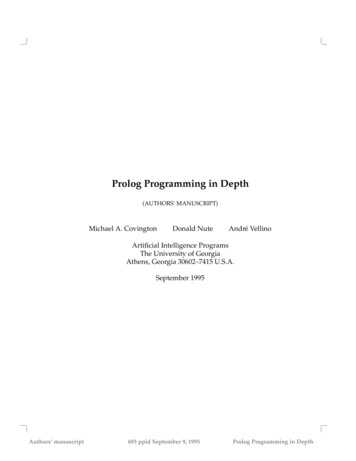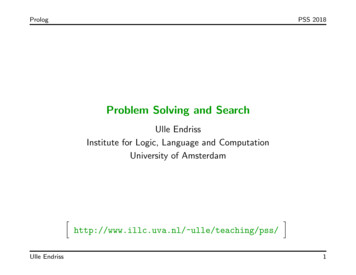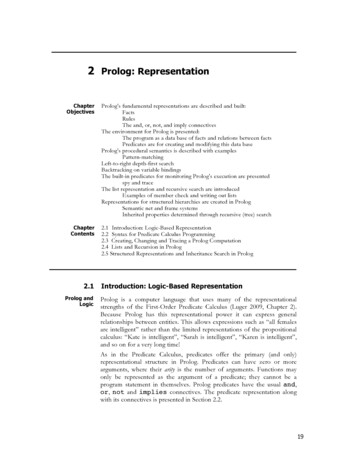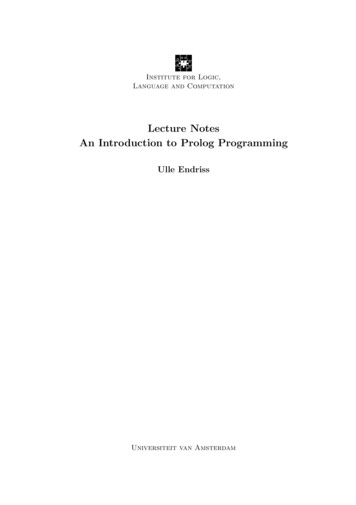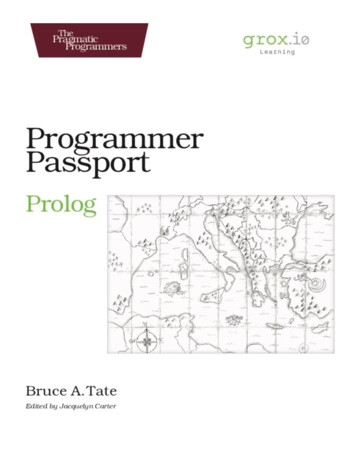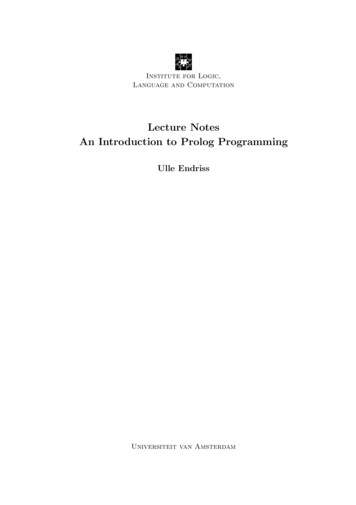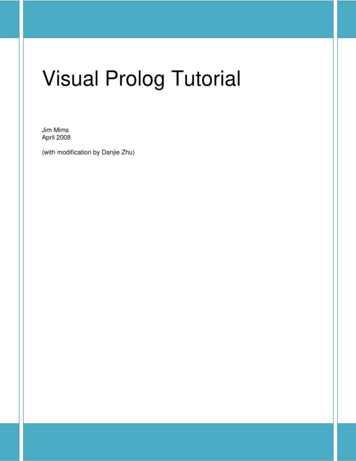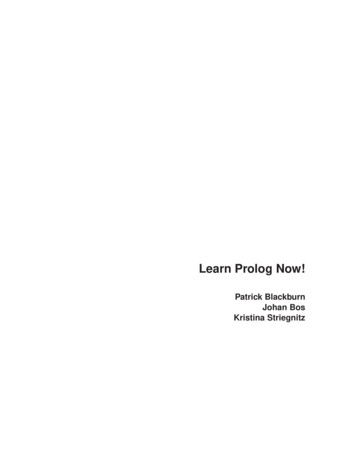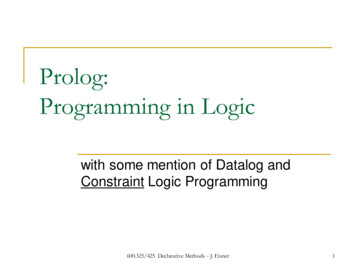
Transcription
Prolog:Programming in Logicwith some mention of Datalog andConstraint Logic Programming600.325/425 Declarative Methods - J. Eisner1
The original declarative programming language Courses in programming languages Prolog is always the declarative language they teach. (imperative, functional, object-oriented, declarative) Alain Colmeraeur & Philippe Roussel, 1971-1973 With help from theorem proving folks such as Robert KowalskiOriginal project: Type in French statements & questions Computer needed NLP and deductive reasoningEfficiency by David Warren, 1977 (compiler, virtual machine)Colmerauer & Roussel wrote 20 years later:“Prolog is so simple that one has the sense that sooner orlater someone had to discover it that period of our livesremains one of the happiest in our memories.“We have had the pleasure of recalling it for this paper overalmonds accompanied by a dry martini.”600.325/425 Declarative Methods - J. Eisner2
Prolog vs. ECLiPSe Most common free Prolog implementation is SWI Prolog. Very nice, though faster ones are for sale (e.g., SICSTUS Prolog).To run Prolog, you can just run ECLiPSe! ECLiPSe is a perfectly good Prolog implementation,although so far we’ve concentrated only on its “extra” features.600.325/425 Declarative Methods - J. Eisner3
Prolog vs. ECLiPSeConstraintprogrammingLogic programming(e.g., Prolog)Constraint logicprogramming(e.g., ECLiPSe)Efficient:Variable orderingValue orderingConstraint joining ble domains are“terms” (including listsand trees)But:Simple, standardsolver: backtrackingand unificationCombo:Tries to combine bestof both worldsLater on we’ll see howBut:Encoding is annoyingVariables limited tofinite sets, ints, reals600.325/425 Declarative Methods - J. Eisner4
Prolog as constraint programming(Person, Food) FooddalcurrysamosascurryrajivburgersrajivdalThe above shows an ordinary constraint between two variables:Person and FoodProlog makes you name this constraint.Here’s a program that defines it: Personsamsamjosiejosieeats(sam, dal).eats(sam, curry).eats(rajiv, burgers).eats(josie, samosas).eats(josie, curry).eats(rajiv, dal). Now it acts like a subroutine! At the Prolog prompt you can type eats(Person1, Food1). % constraint over two variableseats(Person2, Food2). % constraint over two other variables600.325/425 Declarative Methods - J. Eisner5
Simple constraints in Prolog Here’s a program defining the “eats” constraint: eats(sam, dal).eats(sam, curry).eats(rajiv, burgers).Now at the Prolog prompt eats(josie, samosas).eats(josie, curry).eats(rajiv, dal). you can typeeats(Person1, Food1). % constraint over two variableseats(Person2, Food2). % constraint over two other variablesTo say that Person1 and Person2 must eat a commonfood, conjoin two constraints with a comma:Actually, it will eats(Person1, Food), eats(Person2, Food).Prolog gives you possible solutions: Person1 sam, Person2 josie, Food curryPerson1 josie, Person2 sam, Food curry 600.325/425 Declarative Methods - J. Eisnerstart withsolutions wherePerson1 sam,Person2 sam.How to fix?6
eats(sam, dal).eats(sam, curry).eats(rajiv, burgers).eats(josie, samosas).eats(josie, curry).eats(rajiv, dal). Your program file (compiled)Sometimes called the “database”“Query” that you type interactively eats(Person1, Food), eats(Person2, Food). Person1 sam, Person2 josie, Food curry Prolog’sPerson1 josie, Person2 sam, Food curry 600.325/425 Declarative Methods - J. Eisneranswer7
Simple constraints in Prolog Here’s a program defining the “eats” constraint: eats(sam, dal).eats(sam, curry).eats(rajiv, burgers).Now at the Prolog prompt eats(josie, samosas).eats(josie, curry).eats(rajiv, dal). you can typeeats(Person1, Food1). % constraint over two variableseats(Person2, Food2). % constraint over two other variablesTo say that Person1 and Person2 must eat a commonfood, conjoin two constraints with a comma:Actually, it will eats(Person1, Food), eats(Person2, Food).Prolog gives you possible solutions: Person1 sam, Person2 josie, Food curryPerson1 josie, Person2 sam, Food curry 600.325/425 Declarative Methods - J. Eisnerstart withsolutions wherePerson1 sam,Person2 sam.How to fix?8
Queries in PrologThese things you type at the prompt are called “queries.” Prolog answers a query as “Yes” or “No”according to whether it can find a satisfying assignment. If it finds an assignment, it prints the first one before printing “Yes.” You can press Enter to accept it, in which case you’re done,or “;” to reject it, causing Prolog to backtrack and look for another. eats(Person1, Food1). % constraint over two variableseats(Person2, Food2). % constraint over two other variableseats(Person1, Food), eats(Person2, Food).Prolog gives you possible solutions: [ press “;” ]Person1 sam, Person2 josie, Food curryPerson1 josie, Person2 sam, Food curry 600.325/425 Declarative Methods - J. Eisner9
Constants vs. Variables Here’s a program defining the “eats” constraint: eats(sam, dal).eats(sam, curry).eats(rajiv, burgers).Now at the Prolog prompt eats(josie, samosas).eats(josie, curry). you can typeeats(Person1, Food1). % constraint over two variableseats(Person2, Food2). % constraint over two other variablesNothing stops you from putting constants into constraints: eats(josie, Food).% what Food does Josie eat? (2 answers)eats(Person, curry).% what Person eats curry? (2 answers)eats(josie, Food), eats(Person, Food). % who’ll share what with Josie? Food curry, Person sam600.325/425 Declarative Methods - J. Eisner10
Constants vs. Variables Variables start with A,B, Z or underscore: Food, Person, Person2, G123Constant “atoms” start with a,b, z or appear in single quotes: josie, curry, ’CS325’ Other kinds of constants besides atoms: Integers -7, real numbers 3.14159, the empty list [] eats(josie,curry) is technically a constant structureNothing stops you from putting constants into constraints: eats(josie, Food).% what Food does Josie eat? (2 answers)eats(Person, curry).% what Person eats curry? (2 answers)eats(josie, Food), eats(Person, Food). % who’ll share what with Josie? Food curry, Person sam600.325/425 Declarative Methods - J. Eisner11
Rules in Prolog Let’s augment our program with a new constraint:eats(sam, dal).eats(josie, samosas).eats(sam, curry).eats(josie, curry).eats(rajiv, burgers).eats(rajiv, dal).compatible(Person1, Person2) :- eats(Person1, Food),eats(Person2, Food).headbodymeans “if” – it’s supposed to look like “ ” “Person1 and Person2 are compatible if there exists some Food thatthey both eat.”“One way to satisfy the head of this rule is to satisfy the body.”You type the query: compatible(rajiv, X). Prolog answers: X sam. Prolog doesn’t report that Person1 rajiv, Person2 sam, Food dal.These act like local variables in the rule. It already forgot about them.600.325/425 Declarative Methods - J. Eisner12
Rules in Prolog Let’s augment our program with a new constraint:eats(sam, dal).eats(josie, samosas).eats(sam, curry).eats(josie, curry).eats(rajiv, burgers).eats(rajiv, dal).compatible(Person1, Person2) :- eats(Person1, Food),eats(Person2, Food).compatible(Person1, Person2) :- watches(Person1, Movie),watches(Person2, Movie).compatible(hal, Person2) :- female(Person2), rich(Person2). “One way to satisfy the head of this rule is to satisfy the body.”why only “one way”? Why not “if and only if”?allusion to movie Shallow Hal;shows that constants can appear in rules600.325/425 Declarative Methods - J. Eisner13
The Prolog solver Prolog’s solver is incredibly simple.eats(sam,X). Iterates in order through the program’s “eats” clauses.First one to match is eats(sam,dal).so it returns with X dal.If you hit semicolon, it backtracks and continues:Next match is eats(sam,curry).so it returns with X curry.600.325/425 Declarative Methods - J. Eisner14
The Prolog solver Prolog’s solver is incredibly simple.eats(sam,X).eats(sam,X), eats(josie,X). It satisfies 1st constraint with X dal. Now X is assigned.Now to satisfy 2nd constraint, it must prove eats(josie,dal). No!So it backs up to 1st constraint & tries X curry (sam’s other food).Now it has to prove eats(josie,curry). Yes!So it is able to return X curry. What if you now hit semicolon?eats(sam,X), eats(Companion, X). What happens here?What variable ordering is being used? Where did it come from?What value ordering is being used? Where did it come from?600.325/425 Declarative Methods - J. Eisner15
The Prolog solver Prolog’s solver is incredibly simple.eats(sam,X).eats(sam,X), eats(josie,X).eats(sam,X), eats(Companion, X).compatible(sam,Companion). This time, first clause that matches iscompatible(Person1, Person2) :- eats(Person1, Food),eats(Person2, Food).“Head” of clause matches with Person1 sam, Person2 Companion.So now we need to satisfy “body” of clause:eats(sam,Food), eats(Companion,Food).Look familiar?We get Companion rajiv.600.325/425 Declarative Methods - J. Eisner16
The Prolog solver Prolog’s solver is incredibly simple.eats(sam,X).eats(sam,X), eats(josie,X).eats(sam,X), eats(Companion, ion), female(Companion). compatible(Person1, Person2) :- eats(Person1, Food),eats(Person2, Food).st Our first try at satisfying 1 constraint is Companion rajiv (as before). But then 2nd constraint is female(rajiv). which is presumably false. So we backtrack and look for a different satisfying assignment of thefirst constraint: Companion josie. Now 2nd constraint is female(josie). which is presumably true. We backtracked into this compatible clause (food) & retried it. No need yet to move on to the next compatible clause (movies).600.325/425 Declarative Methods - J. Eisner17
Backtracking and Beads Each Prolog constraint is like a “bead” in a stringof beads:callfail exitredoEach constraint has four ports: call, exit, redo, fail600.325/425 Declarative Methods - J. Eisnerslide thanks to David Matuszek (modified)18
Backtracking and Beads Each Prolog constraint is like a “bead” in a stringof beads:exit callexitcallEach constraint has four ports: call, exit, redo, failexit ports feed forward into call ports600.325/425 Declarative Methods - J. Eisnerslide thanks to David Matuszek (modified)19
Backtracking and Beads Each Prolog constraint is like a “bead” in a stringof beads:redo fail redo failEach constraint has four ports: call, exit, redo, failexit ports feed forward into call portsfail ports feed back into redo ports600.325/425 Declarative Methods - J. Eisnerslide thanks to David Matuszek (modified)20
Backtracking and Beads Each Prolog constraint is like a “bead” in a stringof beads:backtracking at workcallfailexitredo Each constraint has four ports: call, exit, redo, failexit ports feed forward into call portsfail ports feed back into redo ports600.325/425 Declarative Methods - J. Eisner21
Backtracking and Beads Each Prolog constraint is like a “bead” in a stringof beads:callfailexitredono way to satisfy this constraint giventhe assignments so far – so first call failsHow disappointing. Let’s try a happier outcome.600.325/425 Declarative Methods - J. Eisner22
Backtracking and Beads Each Prolog constraint is like a “bead” in a stringof beads:callfailexitredocallwe satisfy this constraint, making additionalassignments, and move on 600.325/425 Declarative Methods - J. Eisner23
Backtracking and Beads Each Prolog constraint is like a “bead” in a stringof beads:callfailexitredowe satisfy this constraint, making additionalassignments, and move on but if our assignments cause later constraints tofail, Prolog may come back and redo this one 600.325/425 Declarative Methods - J. Eisner24
Backtracking and Beads Each Prolog constraint is like a “bead” in a stringof beads:callfailexitredowe satisfy this constraint, making additionalassignments, and move on but if our assignments cause later constraints tofail, Prolog may come back and redo this one let’s say we do find a new way to satisfy it.600.325/425 Declarative Methods - J. Eisner25
Backtracking and Beads Each Prolog constraint is like a “bead” in a stringof beads:callfailexitredoIf the new way still causes later constraints tofail, Prolog comes back through the redo port totry yet again.600.325/425 Declarative Methods - J. Eisner26
Backtracking and Beads Each Prolog constraint is like a “bead” in a stringof beads:callfailexitredoIf the new way still causes later constraints tofail, Prolog comes back through the redo port totry yet again.If we’re now out of solutions, we fail too 600.325/425 Declarative Methods - J. Eisner27
Backtracking and Beads Each Prolog constraint is like a “bead” in a stringof beads:callredo failexitredoIf the new way still causes later constraints tofail, Prolog comes back through the redo port totry yet again.If we’re now out of solutions, we fail too sending Prolog back to redo previous constraint.600.325/425 Declarative Methods - J. Eisner28
Rules as nested beadsloves(hal, X) :- female(X), rich(X).loves(hal, X)callfailfemale(X)rich(X)exitredothis is why you can backtrack into loves(hal,X)600.325/425 Declarative Methods - J. Eisnerslide thanks to David Matuszek (modified)29
Alternative rulesloves(hal, X) :- female(X), rich(X).loves(Child, X) :- parent(X, Child).loves(hal, X)callfailfemale(X)rich(X)parent(X, hal)exitredoexitredoafter running out of rich women, hal tries his parents600.325/425 Declarative Methods - J. Eisnerslide thanks to David Matuszek (modified)30
female(X)Alternative l, X)callfailfemale(X)rich(X)parent(X, hal)600.325/425 Declarative Methods - J. Eisnerslide thanks to David Matuszek (modified)exitredoexitredo31
Prolog as a database language The various eats( , ) facts can be regarded as rows in adatabase (2-column database in this case).Standard relational database operations:eats(X,dal).% selectedible(Object) :- eats(Someone, Object).% projectparent(X,Y) :- mother(X,Y).% unionparent(X,Y) :- father(X,Y).sister in law(X,Z) :- sister(X,Y), married(Y,Z). % joinWhy the heck does anyone still use SQL? Beats me.Warning: Prolog’s backtracking strategy can be inefficient. But we can keep the little language illustrated above (“Datalog”)and instead compile into optimized query plans, just as for SQL.600.325/425 Declarative Methods - J. Eisner32
Recursive queries Prolog allows recursive queries (SQL doesn’t).Who’s married to their boss? Who’s married to their boss’s boss? boss(X,Y), boss(Y,Z), married(X,Z).Who’s married to their boss’s boss’s boss? boss(X,Y), married(X,Y).Okay, this is getting silly. Let’s do the general case.Who’s married to someone above them? above(X,X).above(X,Y) :- boss(X,Underling), above(Underling,Y).above(X,Y), married(X,Y).Base case. For simplicity, it says that any X is “above” herself.If you don’t like that, replace base case with above(X,Y) :- boss(X,Y).600.325/425 Declarative Methods - J. Eisner33
Recursive queries above(X,X).above(X,Y) :- boss(X,Underling), above(Underling,Y).above(c,h).% should return Yes matches above(X,X)? noboss(a,b). boss(a,c).boss(b,d). boss(c,f).boss(b,e). abdcefg600.325/425 Declarative Methods - J. Eisnerh34
Recursive queries above(X,X).above(X,Y) :- boss(X,Underling), above(Underling,Y).above(c,h).% should return Yes matches above(X,Y) with X c, Y h boss(c,Underling), matches boss(c,f) with Underling f above(f, h). matches above(X,X)? noboss(a,b). boss(a,c).boss(b,d). boss(c,f).boss(b,e). abdcefg600.325/425 Declarative Methods - J. Eisnerh35
Recursive queries above(X,X).above(X,Y) :- boss(X,Underling), above(Underling,Y).above(c,h).% should return Yesboss(a,b). boss(a,c). matches above(X,Y) with X c, Y hboss(b,d). boss(c,f). boss(c,Underling),boss(b,e). a matches boss(c,f) with Underling f above(f, h).bc matches above(X,Y) with X f, Y h(local copies of X,Y distinct from previous call) d e f boss(f,Underling),g h matches boss(f,g) with Underling g above(g, h). ultimately fails because g has no underlings 600.325/425 Declarative Methods - J. Eisner36
Recursive queries above(X,X).above(X,Y) :- boss(X,Underling), above(Underling,Y).above(c,h).% should return Yesboss(a,b). boss(a,c). matches above(X,Y) with X c, Y hboss(b,d). boss(c,f). boss(c,Underling),boss(b,e). a matches boss(c,f) with Underling f above(f, h).bc matches above(X,Y) with X f, Y h(local copies of X,Y distinct from previous call) d e f boss(f,Underling),g h matches boss(f,h) with Underling h above(h, h). matches above(X,X) with X h600.325/425 Declarative Methods - J. Eisner37
Ordering constraints for speed ababove(X,X).dabove(X,Y) :- boss(X,Underling), above(Underling,Y).cefg Which is more efficient?above(c,h), friends(c,h).friends(c,h), above(c,h).Probably quicker to checkfirst whether they’re friends.If they’re not, can skip thewhole long above(c,h)computation, which mustiterate through descendantsof c.Which is more efficient?above(X,Y), friends(X,Y).friends(X,Y), above(X,Y).For each boss X, iteratethrough all Y below her andcheck if each Y is her friend.(Worse to start by iteratingthrough all friendships: if X has5 friends Y, we scan all thepeople below her 5 times,looking for each friend in turn.)600.325/425 Declarative Methods - J. Eisner38h
aOrdering constraints for speed above(X,X). Which is more efficient?above(X,Y) :- boss(X,Underling), above(Underling,Y).above(X,Y) :- boss(Overling,Y), above(X,Overling).If the query is above(c,e)?1.“querymodes” 2. , ,-, -,-b dcefg1. iterates over descendants of c, looking for e2. iterates over ancestors of e, looking for c.2. is better: no node has very many ancestors, but somehave a lot of descendants. If the query is above(c,Y)?If the query is above(X,e)?If the query is above(X,Y)?1. is better. Why?2. is better. Why?Doesn’t matter much. Why?600.325/425 Declarative Methods - J. Eisner39h
aOrdering constraints for speed above(X,X). Which is more efficient?above(X,Y) :- boss(X,Underling), above(Underling,Y).above(X,Y) :- boss(Overling,Y), above(X,Overling).If the queryWarning:is above(c,e)?Actually, 1. has a significant1.“querymodes” 2. , ,-, -,-b dcefgadvantage in Prolog implementations that1. iteratesdooverdescendants of c, looking for e“1st-argument indexing.”2. iterates over ancestors of e, looking for c.That makesit muchto find2. is better:no nodehas fastervery manyancestors, but somechildren (boss(x,Y))have aa givenlot ofx’sdescendants. than a given y’s parents (boss(X,y)).Soisit above(c,Y)?is much faster to find1. is descendantsbetter. Why?querythan ancestors.If the2. is better. Why?If the query is above(X,e)?If you don’t like that, figureoutmatterhow to much. Why?Doesn’tIf the queryisabove(X,Y)?tell your Prolog to do 2nd-argumentindexing. Or just use subordinate(Y,X)600.325/425DeclarativeMethods - J. Eisnerinsteadof boss(X,Y)!40h
aOrdering constraints for speedb above(X,X). Which is more efficient?above(X,Y) :- boss(X,Underling), above(Underling,Y).above(X,Y) :- above(Underling,Y), boss(X,Underling).1.2.dcefg2. takes forever – literally!! Infinite recursion.above(c,h).% should return Yesmatches above(X,Y) with X c, Y habove(Underling, h)matches above(X,Y) with X Underling, Y habove(Underling, h) 600.325/425 Declarative Methods - J. Eisner41h
aOrdering constraints for speedb above(X,X). Which is more efficient?above(X,Y) :- boss(X,Underling), above(Underling,Y).above(X,Y) :- above(Underling,Y), boss(X,Underling).1.2.dcefg2. takes forever – literally!! Infinite recursion.Here’s how:above(c,h).% should return Yesmatches above(X,X)? no600.325/425 Declarative Methods - J. Eisner42h
aOrdering constraints for speedb above(X,X). Which is more efficient?above(X,Y) :- boss(X,Underling), above(Underling,Y).above(X,Y) :- above(Underling,Y), boss(X,Underling).1.2.dcefg2. takes forever – literally!! Infinite recursion.Here’s how:above(c,h).% should return Yesmatches above(X,Y) with X c, Y habove(Underling, h)matches above(X,X) with local X Underling hboss(c, h) (our current instantiation of boss(X, Underling))no match600.325/425 Declarative Methods - J. Eisner43h
aOrdering constraints for speedb above(X,X). Which is more efficient?above(X,Y) :- boss(X,Underling), above(Underling,Y).above(X,Y) :- above(Underling,Y), boss(X,Underling).1.2.dcefg2. takes forever – literally!! Infinite recursion.Here’s how:above(c,h).% should return Yesmatches above(X,Y) with X c, Y habove(Underling, h)matches above(X,Y) with X Underling, Y habove(Underling, h), 600.325/425 Declarative Methods - J. Eisner44h
Prolog also allows complex terms What we’ve seen so far is called Datalog:“databases in logic.” Prolog is “programming in logic.” It goes alittle bit further by allowing complex terms,including records, lists and trees. These complex terms are the source of theonly hard thing about Prolog, “unification.”600.325/425 Declarative Methods - J. Eisner45
Complex terms at jhu(student(128327, ‘Spammy K', date(2, may, 1986))). at jhu(student(126547, ‘Blobby B’, date(15, dec, 1985))). at jhu(student(456591, ‘Fuzzy W', date(23, aug, 1966))). Several essentially identical ways to find older students: at jhu(student(IDNum, Name, date(Day,Month,Year))),Year 1983.at jhu(student( , Name, date( , ,Year))),Year 1983.usually no need to use at jhu(Person),but sometimes it’s nicePerson student( , ,Birthday),to introduce a temporary nameBirthday date( , ,Year),especially if you’ll use it twiceYear 1983.This query binds Person and Birthday tocomplex structured values, and Year to an int. Prolog prints them all.600.325/425 Declarative Methods - J. Eisnerexample adapted from Ian Davey-Wilson46
homepage(html(head(title("Peter A. Flach")),body([img([align right,src "logo.jpg"]),One big termimg([align left,src "peter.jpg"]),representingh1("Peter Flach's homepage"), an HTML web page.The style onh2("Research interests"),the previousul([li("Learning from structured data"),slide could get.,li(a([href "CV.pdf"],"Full CV"))]),unmanageable.h2("Current activities"),.,You have toh2("Past activities"),remember that.,birthday ish2("Archives"),argument #3.,pagetype(Webpage,researcher):of person, etc.hr,address( )page get head(Webpage,Head),])head get title(Head, Title),)).This nondeterministic query asksperson(Title),whether the page title is a personand “Research” appears in someheading on the page.slide thanks to Peter A. Flach (modified)page get body(Webpage,Body),body get ).
Complex terms at jhu(student(128327, ‘Spammy K', date(2, may, 1986))). at jhu(student(126547, ‘Blobby B’,date(15, dec, 1985))). at jhu(student(456591, ‘Fuzzy W',date(23, aug, 1966))). student get bday( Stu , Bday) :- Stu student( , , Bday) . date get year(Date,Year) :- Date date( , , Year). bad style So you could write accessors in object-oriented style: student get bday(Student,Birthday),date get year(Birthday,Year),at jhu(Student), Year 1983.Answer:Student student(456591, ‘Fuzzy W’, date(23, aug, 1966)),Birthday date(23, aug, 1966),Year 1966.600.325/425 Declarative Methods - J. Eisner48
Complex terms at jhu(student(128327, ‘Spammy K', date(2, may, 1986))). at jhu(student(126547, ‘Blobby B’,date(15, dec, 1985))). at jhu(student(456591, ‘Fuzzy W',date(23, aug, 1966))). student get bday(student( , , Bday), date get year(date( , , Year), Year).Bday).good style So you could write accessors in object-oriented style: student get bday(Student,Birthday),whoa, what are thedate get year(Birthday,Year),variable bindings atat jhu(Student), Year 1983.this point?Answer:Student&BirthdayStudent student(456591, ‘Fuzzy W’, date(23, aug, 1966)),weren’t forced toBirthday date(23, aug, 1966),particular valuesYear 1966.by the constraint.But were forced49600.325/425 Declarative Methods - J. Eisnerinto a relation
Complex terms at jhu(student(128327, ‘Spammy K', date(2, may, 1986))). at jhu(student(126547, ‘Blobby B’,date(15, dec, 1985))). at jhu(student(456591, ‘Fuzzy W',date(23, aug, 1966))). student get bday(student( , , Bday), date get year(date( , , Year), Year).Bday).good style So you could write accessors in object-oriented style: student get bday(Student,Birthday),studentStudentdate get year(Birthday,Year),at jhu(Student), Year 1983.? ?BirthdayAnswer:Student student(456591, ‘Fuzzy W’, date(23, aug, 1966)),Birthday date(23, aug, 1966),Year 1966.600.325/425 Declarative Methods - J. Eisner50
Complex terms at jhu(student(128327, ‘Spammy K', date(2, may, 1986))). at jhu(student(126547, ‘Blobby B’,date(15, dec, 1985))). at jhu(student(456591, ‘Fuzzy W',date(23, aug, 1966))). student get bday(student( , , Bday), date get year(date( , , Year), Year).Bday).good style So you could write accessors in object-oriented style: student get bday(Student,Birthday),studentStudentdate get year(Birthday,Year),at jhu(Student), Year 1983.? ? dateBirthdayAnswer:?YearStudent student(456591, ‘Fuzzy W’, date(23, aug,? 1966)),Birthday date(23, aug, 1966),Year 1966.600.325/425 Declarative Methods - J. Eisner51
Complex terms at jhu(student(128327, ‘Spammy K', date(2, may, 1986))). at jhu(student(126547, ‘Blobby B’,date(15, dec, 1985))). at jhu(student(456591, ‘Fuzzy W',date(23, aug, 1966))). student get bday(student( , , Bday), date get year(date( , , Year), Year).Bday).good style So you could write accessors in object-oriented style: student get bday(Student,Birthday),studentStudentdate get year(Birthday,Year),at jhu(Student), Year 1983.128327 SK dateBirthdayAnswer:1986 YearStudent student(456591, ‘Fuzzy W’, date(23, aug,2 may1966)),Birthday date(23, aug, 1966),Year 1966.600.325/425 Declarative Methods - J. Eisner52
Complex terms at jhu(student(128327, ‘Spammy K', date(2, may, 1986))). at jhu(student(126547, ‘Blobby B’,date(15, dec, 1985))). at jhu(student(456591, ‘Fuzzy W',date(23, aug, 1966))). student get bday(student( , , Bday), date get year(date( , , Year), Year).Bday).good style So you could write accessors in object-oriented style: Failstudent get bday(Student,Birthday),date get year(Birthday,Year),at jhu(Student), Year 1983.Answer:(and backtrack)Student student(456591, ‘Fuzzy W’, date(23, aug, 1966)),Birthday date(23, aug, 1966),Year 1966.600.325/425 Declarative Methods - J. Eisner53
How does matching happen? eats(sam, dal).eats(josie, sundae(vanilla, caramel)).eats(rajiv, sundae(mintchip, fudge)).eats(robot(’C-3PO’), Anything). % variable in a factQuery: eats(A, sundae(B,fudge)).Answer: A rajiv, B mintchip600.325/425 Declarative Methods - J. Eisner54
How does matching happen? eats(sam, dal).eats(josie, sundae(vanilla, caramel)).eats(rajiv, sundae(mintchip, fudge)).eats(robot(’C-3PO’), Anything). % variable in a factQuery: eats(A, sundae(B,fudge)).What happens when we try to match this against facts?eatsAsundaeB A samfudgeeatssamdalNo match sundae dal(more precisely, sundae/2 dal/0)600.325/425 Declarative Methods - J. Eisner55
How does matching happen? eats(sam, dal).eats(josie, sundae(vanilla, caramel)).eats(rajiv, sundae(mintchip, fudge)).eats(robot(’C-3PO’), Anything). % variable in a factQuery: eats(A, sundae(B,fudge)).What happens when we try to match this against facts?eatsAsundaeB A josiefudge B vanillaeatsjosiesundaeNo match vanilla caramel fudge caramel600.325/425 Declarative Methods - J. Eisner56
How does matching happen? eats(sam, dal).eats(josie, sundae(vanilla, caramel)).eats(rajiv, sundae(mintchip, fudge)).eats(robot(’C-3PO’), Anything). % variable in a factQuery: eats(A, sundae(B,fudge)).What happens when we try to match this against facts?eatsAsundaeB A rajivfudgeeatsrajivsundaeMatch! B mintchipmintchip fudge 600.325/425 Declarative Methods - J. Eisner57
How does matching happen? eats(sam, dal).eats(josie, sundae(vanilla, caramel)).eats(rajiv, sundae(mintchip, fudge)).eats(robot(’C-3PO’), Anything). % variable in a factQuery: eats(A, sundae(B,fudge))., icecream(B).What happens when we try to match this against facts?Match!eats eats(B still unknown) A robot(’C-3PO’)AsundaeBfudgerobotAnything Anything C-3POsundae(B,fudge)600.325/425 Declarative Methods - J. Eisner58
How does matching happen? eats(sam, dal).eats(josie, sundae(vanilla, caramel)).eats(rajiv, sundae(mintchip, fudge)).eats(robot(’C-3PO’), Something) :- udge).icecream(chocolate).food(sundae(Base, Topping)) :- icecream(Base),food(Topping).Query: eats(robot(A), sundae(B,fudge)).Answer: A ’C-3PO’, B can be any kind of ice cream600.325/425 Declarative Methods - J. Eisner59
How does matching happen? Let’s use a “ ” constraint to invoke unification directly Query: foo(A,bar(B,f(D))) foo(blah(blah), bar(2,E)).Answer: A blah(blah), B 2, E f(D)fooAfoobarBblahfblahbar2EDThis is like unit propagation in DPLL SAT solvers. Unifying 2 nodes “propagates”: it forces their children to be unified too.(As in DPLL, propagation could happen in any order. Options?) This may bind some unassigned variables to particular nodes.(Like assigning A 0 or A 1 in DPLL.) In case of a conflict,600.325/425backtracktoMethodsprev.- J.decision,undoing all propagation.60DeclarativeEisner
Two obvious recursive definitions Term (the central data structure in Prolog programs)1.Any variable is a term (e.g., X).2.Any atom (e.g., foo) or other simple constant (e.g., 7) is a term.3.If f is an atom and t1, t2, tn are terms,then f(t1, t2, tn) is a term.This lets us build up terms of any finite depth.Unification (matching of two terms )1.If or is a variable, succeeds and returns immediately:side effect is to bind that variable.2.If is f(t1, t2, tn) and is f(t1’, t2’, tn’), then recurse:
600.325/425 Declarative Methods - J. Eisner 3 Prolog vs. ECLiPSe Most common free Prolog implementation is SWI Prolog. Very nice, though faster ones are for sale (e.g., SICSTUS Prolog). To run Prolog, you can just run ECLiPSe! ECLiPSe is a perfectly good Prolog implementation, although so far we've concentrated only on its "extra" features.
